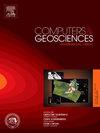Fault representation in structural modelling with implicit neural representations
IF 4.4
2区 地球科学
Q1 COMPUTER SCIENCE, INTERDISCIPLINARY APPLICATIONS
引用次数: 0
Abstract
Implicit neural representations have been demonstrated to provide a flexible and scalable framework for computer graphics and three-dimensional modelling and, consequently, have found their way also into geological modelling. These networks are feature-based and resolution-independent, making them effective for modelling geological structures from scattered interface points, units, and structural orientations. Despite the promising characteristics of existing implicit neural representation approaches, modelling faults within implicit neural representations remains a significant challenge. In this work, we present a fault feature encoding approach to represent faults in implicit neural representations, where the discontinuous information is concatenated as additional features of observation points and query points for network input. We apply this methodology first to a synthetic model to evaluate its efficacy, and subsequently to a real-world dataset from a part of the Gullfaks field in the northern North Sea. The modelling results demonstrate the method’s capacity to generate a well-defined implicit scalar field while preserving sharp transitions at fault locations. Moreover, this work mentions the advantages of the presented approach over using Boolean operations and discontinuous activation functions. Furthermore, we discuss the potential opportunity to integrate prior domain knowledge and geophysics datasets into structural modelling by embedding them as model input features or incorporating them as constraints by loss functions.
利用隐式神经表征进行结构建模中的故障表征
隐式神经表征已经被证明为计算机图形学和三维建模提供了一个灵活和可扩展的框架,因此,它们也被用于地质建模。这些网络基于特征且与分辨率无关,因此可以有效地从分散的界面点、单元和构造方向对地质结构进行建模。尽管现有的隐式神经表示方法具有很好的特点,但隐式神经表示中的错误建模仍然是一个重大挑战。在这项工作中,我们提出了一种故障特征编码方法来表示隐式神经表示中的故障,其中不连续信息被连接为网络输入的观测点和查询点的附加特征。我们首先将该方法应用于一个综合模型来评估其有效性,然后将其应用于北海北部Gullfaks油田部分地区的真实数据集。建模结果表明,该方法能够生成定义良好的隐式标量场,同时保持故障位置的急剧过渡。此外,这项工作提到了所提出的方法相对于使用布尔运算和不连续激活函数的优点。此外,我们讨论了将先验领域知识和地球物理数据集集成到结构建模中的潜在机会,方法是将它们作为模型输入特征嵌入或将它们作为损失函数的约束。
本文章由计算机程序翻译,如有差异,请以英文原文为准。
求助全文
约1分钟内获得全文
求助全文
来源期刊

Computers & Geosciences
地学-地球科学综合
CiteScore
9.30
自引率
6.80%
发文量
164
审稿时长
3.4 months
期刊介绍:
Computers & Geosciences publishes high impact, original research at the interface between Computer Sciences and Geosciences. Publications should apply modern computer science paradigms, whether computational or informatics-based, to address problems in the geosciences.
 求助内容:
求助内容: 应助结果提醒方式:
应助结果提醒方式:


